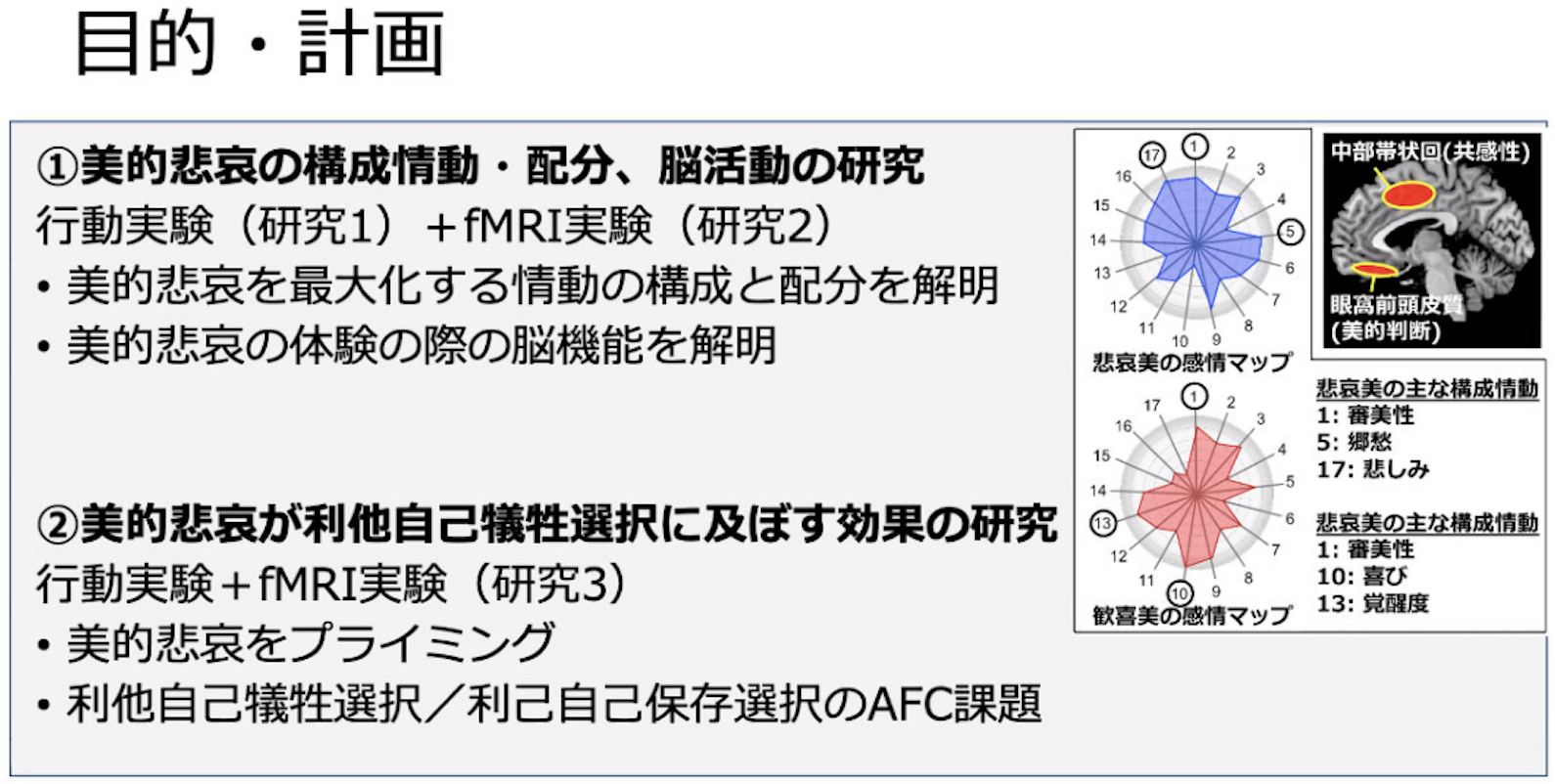Tomohiro Ishizu

Professor, Faculty of Literature, Kansai University
Message
Please do not hesitate to contact us.
Research Plan Overview
Humans possess altruism, empathy, and other attributes that motivate them to willingly contribute to other individuals or groups, a behavior that steps beyond simple decision-making that considers personal pleasure/displeasure. “Tragic beauty”, an aesthetic experience that blends sorrow with beauty, can encourage altruism within individuals and has recently attracted interest not only in the humanities but also in cognitive science and empirical aesthetics. However, little is known about the actual affects that comprise the mixed emotion, as well as how it occurs.
This study aims to uncover the affects that constitute tragic beauty, in addition to the behavioral characteristics and brain mechanisms of its influence over human-like, altruistic, self-sacrificial decision-making. This is achieved through three experiments: 1) a behavioral experiment to elucidate the constituent emotions, 2) MRI experiment (a) to identify the neural basis of tragic beauty, and 3) MRI experiment (b) to investigate the neural basis of tragic beauty encouraging altruistic self-sacrifice.
This study provides a quantitative interpretation of tragic beauty, a topic conventionally discussed qualitatively, from the perspective of affective informatics, while also helping to better understand an aesthetic concept with negative valence and human nature beyond the idea of displeasure.

Aesthetic experiences with negative valence
A mixed state of positive and negative valence (mixed emotion) → Expressed and discussed in the fields of art and aesthetics
“Aesthetic sorrow” = beauty + sorrow Tragic drama, somber music, etc. Aesthetic experiences with negative emotions may encourage prosociality and empathy Aesthetic sorrow = greater empathy (Ishizu, 2019) Has an influence on decision-making beyond individual displeasure?

Objectives and plans
(1) Research on the constituent affects and distribution, as well as brain activity of aesthetic sorrow Behavioral experiment (study 1) + fMRI experiment (study 2) Investigating the composition and distribution of affect that maximize aesthetic sorrow Investigating the brain functions during one’s experience of aesthetic sorrow
(2) Research on the effect that aesthetic sorrow on altruistic self-sacrificial decisions Behavioral experiment + fMRI experiment (study 3) Priming aesthetic sorrow 2AFC task between altruistic self-sacrificial choice and self-serving self-preservative choice
The academic context of this study
Tragic beauty as a mixture of emotions: Displeasure is a state that biological individuals should generally avoid. It is natural to pursue a state of pleasure, which has positive valence, as opposed to one of displeasure, which has negative valence, and scientific studies on pleasure have primarily centered on positive and pleasant emotions. However, in certain cases, humans may willingly seek value in displeasure — for instance, taking self-sacrificial and moral actions. When individuals sacrifice themselves to help others (altruistic self-sacrifice), it causes damage and pain at least momentarily, resulting in displeasure or negative emotions.
At first glance, this may seem to contradict the individual’s survival; however, self-sacrificial behavior is related to the most fundamental elements of human nature, such as ethics and altruism. The ability to step beyond personal pleasure/displeasure and motivate oneself to contribute to other individuals or groups is very unique to humans and is an important act of judgment for social creatures. Art and aesthetics have continued to discuss the value of such negative valences, which modern rational sciences have overlooked. We humans can perceive positive aesthetic value, such as beauty, from tragic artworks, somber music, and other forms of tragic beauty that express sorrow and pain.
According to Cowen et al., the complex emotions that people perceive in art and other media are determined by the distribution of several basic affects (Cowen & Keltner, 2019). The same can be said for tragic beauty, which, as F. Schiller describes as “artificial misery”, is not an actual emotion but rather a mixture of the negative valence of “sorrow” and positive aesthetic experience of “beauty” (Poetics by Aristotle, for instance). Psychological experiments have also shown that tragic beauty is a combination of multiple affects (Kawakami et al., 2013; Ishizu, 2019). However, little is known about the affects that actually constitute tragic beauty and the affective distribution that would maximizes one’s experience of tragic beauty.
Tragic beauty, empathy, and altruistic self-sacrifice: Interestingly, previous research suggests that tragic beauty and other aesthetic experiences with negative valence may encourage altruistic self-sacrifice behavior (Ishizu & Zeki, 2013; Piff et al., 2015). A study by an applicant of this research group also reports that the experience of tragic beauty triggers activity in brain regions responsible for empathy and understanding others’ pain, namely the cingulate gyrus and supplementary motor area (Ishizu & Zeki, 2017). This is a phenomenon that cannot be observed during simple experiences of pleasure. Thus, the experience of tragic beauty may contribute to abilities that are crucial for humans to live as social creatures, such as empathy and decision-making based on human decency. Medical universities in North America have recently introduced programs to develop the empathy and altruistic thinking of medical students through understanding artworks that express negative affects like tragic beauty, and have reported their results (Mangione et al., 2018). However, empirical studies of this topic are limited and the underlying brain mechanisms of how tragic beauty encourages altruistic thinking are still unknown.
As mentioned above, little is known about the specific affects that constitute the mixed-emotion experience of tragic beauty and why it encourages altruistic self-sacrificial behavior. To clarify these points, it is essential that tragic beauty, a topic of qualitative discussion in the past, is examined through a quantitative approach from the perspective of affective informatics.


